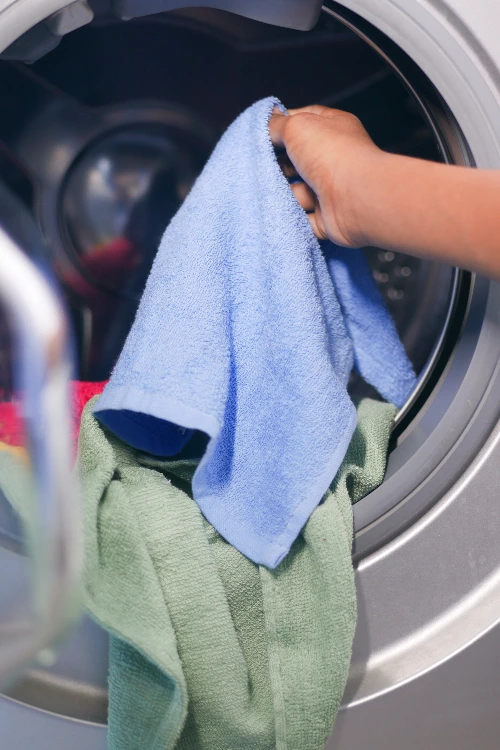Ever struggled with your favorite clothes shrinking after a trip through the dryer? You are not alone. Many garments, particularly those made from natural fibers, can shrink when exposed to high temperatures.
This blog will guide you on identifying what fabric shrinks in the dryer and how to prevent it. Stay tuned for practical advice that could save your next load of laundry!
What Fabric Shrinks in the Dryer: 5 Causes of Clothing Shrinkage

Fabric shrinkage occurs when clothing is exposed to heat and moisture, causing the fibers to constrict and decrease in size. The causes of clothing shrinkage can vary. Here I list 5 common causes of clothing shrinkage.
- Heat: Exposing clothes to high temperatures can cause shrinkage. Heat can cause the fibers in the fabric to contract, resulting in a smaller size.
- Agitation: Aggressive drying cycles that involve excessive agitation. It can also contribute to clothing shrinkage. The constant movement and friction can cause the fabric to shrink.
- Incorrect drying settings: Using the wrong settings on your dryer, such as using a high heat setting when it should be low, can lead to shrinkage. It’s important to follow the care instructions on the clothing label.
- Fabric type: Different fabrics have different shrinkage properties. Natural fibers like cotton and wool are more susceptible to shrinkage compared to synthetic fibers. Blended fabrics, which contain a mix of natural and synthetic fibers, may also shrink unevenly.
- Poor quality or improper manufacturing: Clothing that is poorly made or not properly pre-shrunk during manufacturing may be more likely to shrink when washed.
What Fabric Shrinks in the Dryer: 10 Shrinkage Fabrics
Some fabrics are more prone to shrinking in the dryer than others.
1. Cotton

Cotton falls into the category of fabrics prone to shrinkage in the dryer. Heat exposure specifically causes 100% cotton clothes to contract significantly.
Therefore, garments made entirely from this natural material may fit you smaller after a hot tumble cycle. However, blend varieties containing cotton present less risk of notable size reduction.
So when laundering your beloved cotton shirt or cozy jeans, proceed with caution! This way, you can enjoy your cotton pieces longer. Meanwhile, you don’t have to worry about unexpected changes in their fit post-drying session.
2. Wool
Wool garments rank high among fabrics that shrink significantly in the dryer. Exposure to the dryer’s intense heat can cause wool fibers to contract, resulting in noticeable garment shrinkage.
Moreover, wool can undergo a process called “felting”. Individual fibers start to mat together when subjected to such heat conditions. This change can alter your favorite sweater’s texture and fitting drastically.
To avoid damaging your wool clothes, it’s best practice to opt for air-drying methods or take them straight to the drycleaner.
3. Lace
Lace is a fabric that requires special care when it comes to drying. If you put lace garments in the dryer, they can shrink and become damaged easily. This delicate material is prone to weakening or tearing during the dryer cycle.
To keep your lace items in good condition, it’s best to air-dry them by laying them flat or hanging them up.
4. Linen
Linen garments and bedsheets can shrink when exposed to high heat in the dryer or when they become wet. Made from flax fibers, linen fabrics are prone to relaxation and contraction shrinkage at high temperatures.
It is important to consider air-drying them instead of using a hot dryer cycle. So, if you want to keep your linen pieces looking their best, it’s best to avoid subjecting them to the drying process in the machine.
5. Silk
Silk is a fabric that is prone to shrinking in the dryer due to its delicate nature. The high heat and agitation can cause silk to lose its luster and shrink in size. It’s important to avoid putting silk in the washer or dryer, as it can become damaged easily.
Instead, handwashing and air-drying are recommended for silk fabrics. Prolonged exposure to heat and water can cause contraction and shrinkage in silk, so it’s best to handle this material with care.
(Related: FABRICS SIMILAR TO SILK: 20 AWESOME SILK ALTERNATIVES)
6. Viscose
Viscose is one of those materials associated with fabrics that are prone to shrinking in the dryer. What’s worse, each time you put viscose garments in the dryer, they are likely to shrink even more. To prevent this from happening, it’s best to air-dry viscose fabrics instead of using the dryer.
7. Rayon
Rayon is a semi-synthetic fabric that can shrink and become damaged in the dryer. The heat and agitation of the dryer can cause rayon fabrics to lose their original size and shape. It is best to air-dry rayon garments to prevent shrinkage.
8. Cashmere

Cashmere, a luxurious and soft fabric, is notorious for shrinking in the dryer. When exposed to heat and agitation, cashmere fibers can constrict and cause the garment to shrink significantly.
Additionally, the delicate nature of cashmere makes it prone to warping and felting at high temperatures. It’s important to avoid washing or drying cashmere in a machine, as it will likely shrink and wear quickly.
9. Spandex
Spandex is a fabric that can shrink in the dryer, although it tends to stretch back out once you wear it. This synthetic material is known for its elasticity and ability to retain its shape. But excessive heat from the dryer can cause some shrinkage. It’s best to follow the care instructions on your spandex garments.
10. Leather
Leather, including faux leather, is prone to shrinking if put in the dryer. It is important to note that leather should never be washed or dried in a machine. The same goes for suede, which is similar to leather and can also become damaged if exposed to high heat.
To prevent any damage or shrinkage, it’s best to avoid putting leather or suede garments in the dryer altogether. Instead, consider spot cleaning or taking them to a professional cleaner when necessary.
Fabrics don’t Shrink in the Dryer
1. Polyester
Polyester is a fabric that does not shrink in the dryer. It has a low shrinkage rate, which makes it an ideal choice for garments that need to withstand dryer conditions. Polyester blends are commonly used to create fabrics that are more resistant to shrinkage.
Unlike wool or other natural fibers, polyester fabrics are less likely to warp or “felt” when exposed to high heat in the dryer. However, extremely high temperatures can still cause some minimal shrinkage in polyester fabrics.
2. Nylon
Nylon is one fabric that does not shrink in the dryer. The heat and agitation of the drying process do not affect nylon, unlike materials like wool, silk, and pure cotton. This means that you can confidently dry your nylon garments without worrying about them shrinking or losing their shape.
Nylon maintains its size and shape even after being subjected to the drying process. So if you have nylon clothing items that need to be washed and dried, feel free to toss them in the dryer without any concerns about shrinkage.
3. Acrylic
Acrylic fabrics are less likely to shrink in the dryer. This synthetic material is known for its ability to retain its shape and resist shrinking even when exposed to high temperatures.
So if you have clothing or other items made from acrylic fabric, you can feel more confident about putting them in the dryer.
Tips on How to Prevent Shrinkage

To prevent the shrinkage of your clothing in the dryer, follow these tips:
- Read and apply the care label instructions to your garments. They provide specific information on how to properly care for each fabric.
- Avoid using high heat settings on the dryer. Opt for a lower temperature or even the air-dry setting to reduce the risk of shrinking.
- If possible, hang-dry your clothes instead of using the dryer. This method allows the fibers to relax and prevents excess shrinkage.
- When washing cotton blends or other shrink-prone fabrics, use cold water instead of hot or warm water. Cold water helps preserve the integrity of the fibers and reduces their likelihood of shrinking.
- Avoid overcrowding the dryer by drying fewer items at a time. Overcrowding can lead to restricted airflow and uneven drying, which may cause shrinkage.
- Consider drycleaning certain fabrics like lace, leather, and suede. Drycleaners have specialized cleaning products and techniques that minimize the risk of damage or shrinkage.
- If you notice that a garment has shrunk slightly after washing, you can try gently stretching it back into shape while it is still damp. This can help restore some of its original size.
Conclusion
When it comes to fabric shrinkage in the dryer, certain materials are more susceptible than others. Fabrics like wool, silk, lace, linen, and viscose are susceptible to shrinking due to their delicate nature.
On the other hand, polyester, nylon, and acrylic are less likely to shrink in the dryer. To prevent shrinkage and preserve your garments’ quality, it’s important to follow the care instructions on the label and consider air-drying for more sensitive fabrics.
Discover more sewing techniques and fabric secrets on Longan Craft Blog!






